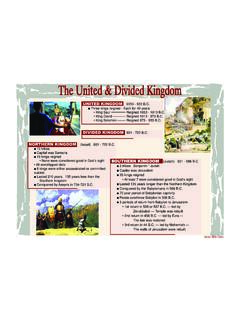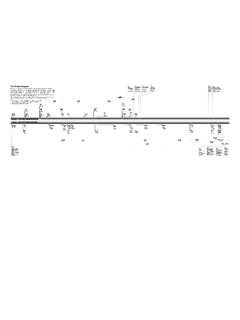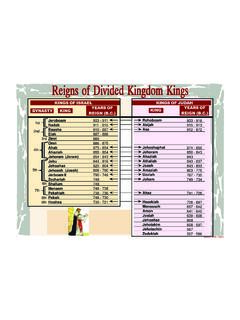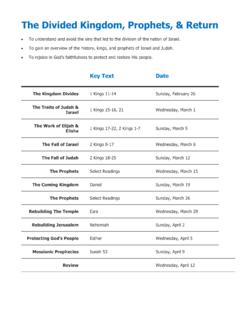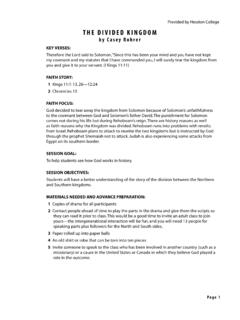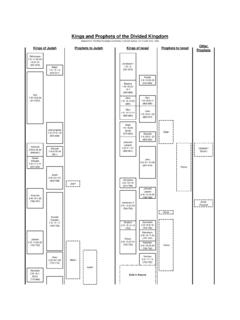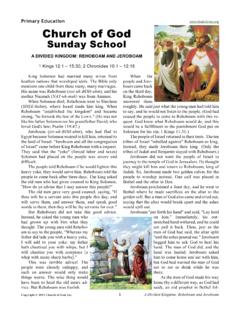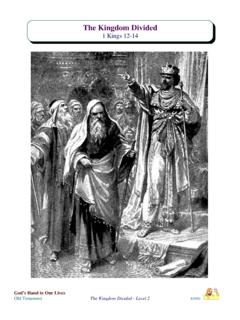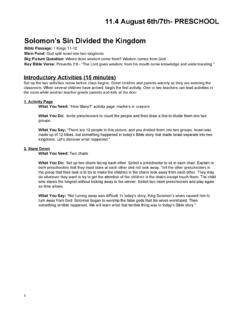Transcription of Andrews University Seminary Studies, Vol. 45, No. 2, 278-283
1 Page 1 of 6 Andrews University Seminary studies , Vol. 45, No. 2, 278-283 M. Christine Tetley, The Reconstructed Chronology of the divided kingdom (Winona Lake, Ind.: Eisenbrauns, 2005). This book is a revision of Mrs. Tetley s doctoral dissertation on the biblical chronology from the death of Solomon until the fall of Samaria. Eisenbrauns has done a fine job in formatting the book, providing a wide-page layout that is useful for displaying the numerous charts and tables. Indexes of authors, scriptural references, and royal names are provided. The author sees as her goal the presentation of a chronology that would replace the work of Edwin Thiele for this period of time. Overall, the system of Thiele and those who built on his research is characterized as too complicated, since it is based on giving consideration to whether the two kingdoms might have used a different calendar, or whether some regnal years and synchronisms might have been measured from the start of a coregency, or whether the first partial year of a monarch was considered his zero year or his first year (accession and non-accession counting, respectively).
2 Dr. Tetley therefore sees the need for a fresh approach to the chronology of the divided kingdom . Her hypotheses are spelled out (p. 118) as follows: Only one dating system is employed in 1-2 Kings for both Judah and Israel, and that dating system was invariant over the time of the divided kingdoms. The regnal years of kings were counted from the day of accession, in the same way that modern people reckon birthdays, and so there is no need to consider whether the calendar year started in Nisan or Tishri. Regnal years were not exact, but were rounded up or down, with no explanation given of how this was done. No coregencies or rival reigns will be considered, since they are witnessed neither by the regnal formulas nor any other textual evidence. Tetley s method can be described as a tour de force of developing a chronology based on these simplifying assumptions.
3 It is only secondarily a text-critical methodology, which is Tetley s own characterization of her approach. The second distinctive of the author s method is her endeavor to examine all recensions, Hebrew and Greek, of the Books of Kings, and to determine which recension, or combination of recensions, points to the original chronological data. Chapter 2 provides the background of these recensions. Chapter 3 then has useful charts for comparison of the chronological data reign lengths and synchronisms found in these various textual traditions. Chapter 4 looks more closely at c2, a tenth-century AD manuscript in the Lucianic family. For the second half of the period of the divided monarchies, Tetley offers the opinion that c2 is the only extant text to give synchronisms and regnal years that provide an internally consistent chronology for this period (p.)
4 63). To the author s credit, she nevertheless cites scholars who have decided that the Lucianic MSS in general, and c2 in particular, are next to worthless for determining the chronology of the period. The reader is thus forewarned that the chronology about to be constructed will be in contradiction to the judgment of many critical studies of textual traditions in the Books of Kings. After a chapter dealing with regnal formulas, Chapters 6 through 9 develop the Reconstructed Chronology, as based on the presuppositions presented earlier and the predilection for Greek texts, particularly c2, over the MT. As mentioned previously, the Page 2 of 6 methodology here is primarily presuppositional, not text-critical. This can be seen in the various instances where Tetley finds no textual support for her reconstruction, and indeed where all relevant texts contradict it, but the logical consequences of the presuppositions are allowed to override all evidence textual, inscriptional, or otherwise.
5 Even the text-critical method, which can usually be bent to favor an author s presuppositions, is discarded by Tetley when it contradicts her presuppositions. The treatment given to the Tyrian king list illustrates this approach. This list, as cited in Josephus s Against Apion, allows a calculation of the time that elapsed between the start of construction of Solomon s Temple and the founding of Rome. Once the date for the founding of the Temple is calculated by this method, the biblical data for the regnal years of Solomon give 932 BC as the date of the beginning of the divided kingdoms, plus or minus two years at the maximum (see William Barnes, studies in the Chronology of the divided Monarchy of Israel, 29-55). This agrees remarkably well with Thiele s date of 931 BC, but it contradicts the Reconstructed Chronology date (981 BC) by forty-nine years.
6 To deal with this, Tetley starts by accepting the finding of Barnes, F. M. Cross, and other scholars that the Tyrian king Balezeros (Ba li-manzer) is attested in the inscriptions of Shalmaneser III as giving tribute in Shalmaneser s eighteenth year, but she assigns this to 885 BC, forty-four years earlier than the 841 BC acknowledged by Assyriologists. The 841 date is also consistent with Thiele s dates for Jehu (841-814 BC), who gave tribute at the same time as Balezeros. Here the Tyrian data, the conventional interpretation of the Assyrian data, and the biblical data agree, and they all contradict Tetley s chronology. The wisest course, once so many contradictions had been encountered, would have been to modify or discard the various presuppositions used to construct that chronology. Instead, Tetley added to them: she assumed that the Tyrian chronology needed to be extended, and the presumption was made that Dido, founder of Carthage, did not leave Tyre in Pygmalion s seventh year, but in his forty-seventh, for which there is no textual warrant.
7 Regarding the tribute of Balezeros in the eighteenth year of Shalmaneser III, Tetley assumed that the usual interpretation of the Assyrian data must be wrong (since it was not in keeping with her assumptions), so she rejected the Assyrian Eponym Canon for all years before the Bur-Sagale eclipse of 763 BC. She further assumed that the Israelite king Ia a who gave tribute to Shalmaneser at the same time as Balezeros was Joram, not Jehu, and in 885 BC instead of in 841 BC. Tetley adds extra presuppositions like this throughout her work, so that her system ends up being more complicated than the system of Thiele that she rejected as too complicated. Tetley s rejection of the Assyrian Eponym Canon for all dates before 763 BC will not find a ready acceptance among Assyriologists. The rationale for rejection is an extra name during the reign of Adad-Nirari III in one list of eponyms.
8 Thiele (The Mysterious Numbers of the Hebrew Kings, 3rd ed., 73-76) explains this extra name, and shows that the Eponym Canon is consistent with the Khorsabad King List and the other copies of the Eponym Canon when the single extra eponym, found in only one inscription, is recognized as an erroneous addition. Thiele s treatment shows the proper usage of the text-critical method, which cannot be said of Tetley s handling of the same Assyrian texts. When she claims that an extra twenty-two eponyms are missing from the reign of Adad-Nirari III, no Assyrian inscriptions can be cited that give these eponyms, nor is any explanation given how this stretching out Adad-Nirari s reign to fifty years can be compatible with the twenty-eight years given to him in the Assyrian King List. It is Page 3 of 6 Thiele who uses properly the text-critical method in studying these data, whereas the approach of Reconstructed Chronology is clearly presupposition-driven, not text-driven.
9 Has this approach been able to make sense out of the biblical data for the divided monarchies? There are thirty-three monarchs involved in the two kingdoms for this period of time. The reign lengths given for these monarchs in Tetley s chronology differ from any text, MT or Greek, in eight cases, six of which are more than the one year that Tetley could attribute to rounding. For seven of the eight cases, all Greek MSS agree with the MT, contra Tetley s figures. For synchronisms between these kings the statistics are equally bad: of the thirty-seven synchronisms between Israel and Judah that can be constructed from Tetley s charts, twelve of them find no support in any textual tradition, MT or Greek. In eleven of these cases, the difference is more than one year. Also in eleven cases, all Greek MSS that give a synchronism agree with the MT against Tetley.
10 The Reconstructed Chronology, therefore, is in poor agreement with the extant Greek data or with any combination of Greek and Hebrew data. Its chronology is ultimately not determined by the underlying biblical texts, nor is it determined by the chronology of Assyria, Tyre, or any other surrounding nation. It is determined by the author s presuppositions. If we apply a similar test to Thiele s chronology for the same period, we find that all Thiele s figures for reign lengths are in harmony with the MT. With regard to synchronisms, Thiele rejected the synchronisms between Hezekiah and Hoshea in 2 Kgs 18, and he also failed to understand the Hoshea/Ahaz synchronism of 2 Kgs 17:1. These synchronisms are all dealt with adequately by the scholars who corrected Thiele s deficiencies, most notably by Leslie McFall.

